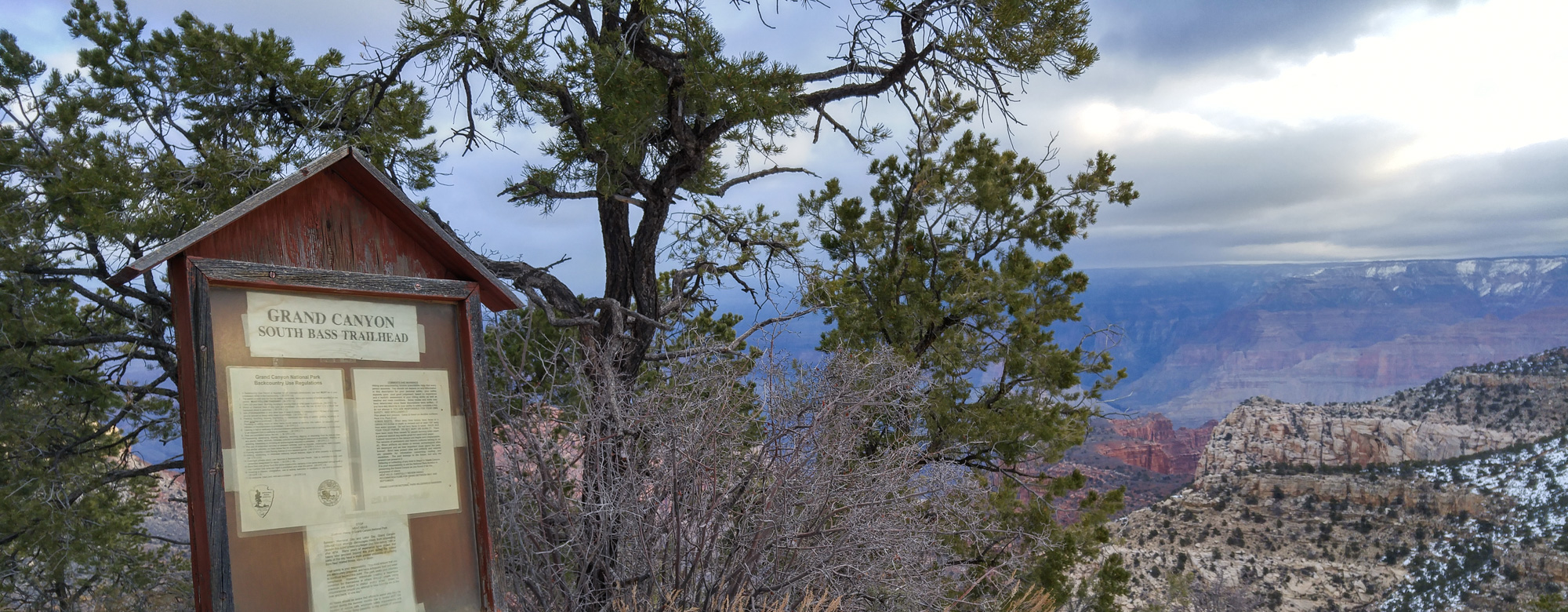
The South Bass Trail Head Sign. We got to watch an amazing sunrise from the rim.
Tusayan, AZ – 4 Corner Film Logistics (4CFL) recently completed an extraction and insertion of a National Geographic team that is through-hiking the Grand Canyon. The team’s journey will require them to hike more than 650 miles through the length of the Grand Canyon. For this particular leg, the team had requested a pickup and dropoff at the South Bass trailhead. Getting to the South Bass trailhead requires driving more than 30 miles of dirt road, including a few miles on the Havasupai Indian reservation, and navigating the pasture wash. Under ideal (dry) conditions, a high clearance four wheel drive vehicle is required to get down the wash. When you’re travelling out there in the middle of winter, after the region has received several feet of snow, all bets are off.
Hours of research ensued. Countless phone calls were made, and ideas from snow cats to Polaris Rangers were discussed and explored. Ultimately, we were unable to obtain solid information on what we were going into, so we packed with the “better to have it, and not need it; than need it, and not have it approach.” The folks at the Backcounty Office thought we were crazy to head out there when everything is covered in snow, but knowing that the Nat Geo Crew was counting on us meant we were committed to getting to the trailhead. We kitted up, and prepared ourselves to get muddy.
At zero dark thirty, we set off in a truck and two Polaris Rangers loaded for bear. As we were leaving Tusayan, we ran into Steve Hatch, who after learning what we were up to, decided to join our adventure. We settled in for the drive, and started following the red line on our GPS units. The going was easier than expected and progress was good. The biting cold that lead Harlan to bust out his survival suit was also doing us a big favor, in freezing everything solid. What would be a soupy, mud-bog of a mess of a road in the daytime was all frozen mud and snowpack. We had heard horror stories about what our route was like when muddy, so we were very thankful to that we were only having to deal with glare ice, and not much in the way of mud. At the Havasupai Indian reservation line, we dropped our truck as a bail out option and pressed on with Steve’s Jeep and the two Rangers.
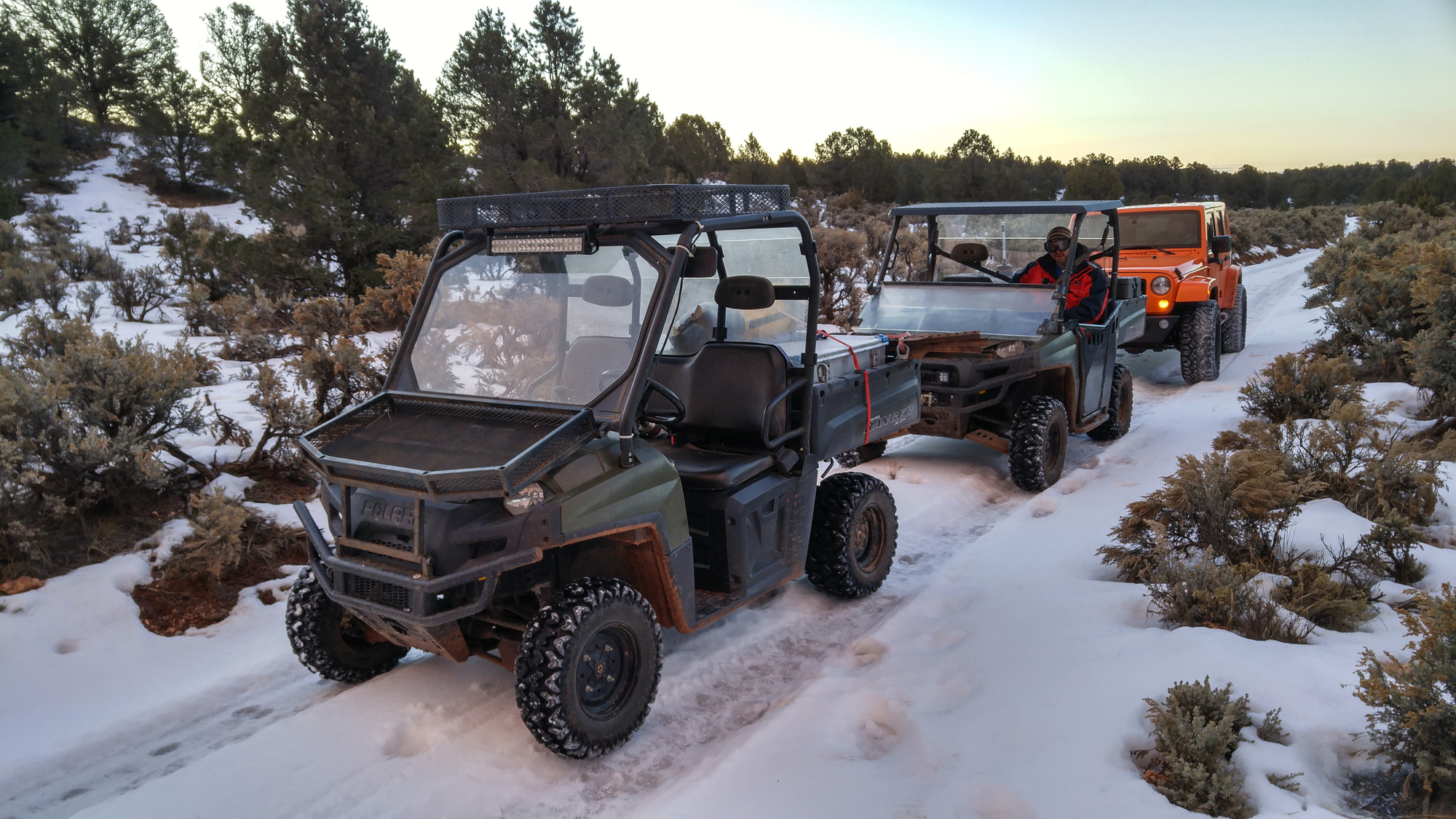
Our Pasture wash convoy just before sunrise.
Now on Havasupai land, we were feeling even more fortunate that the ground was frozen. The road was carved up with ruts made by other vehicles that had clawed their way down the road, making ruts that the Forrest service wouldn’t approve of. After several miles of this we reached the Pasture wash turn off. The Pasture wash road was snowpacked, and we were able to make good progress with a generous application of the skinny pedal. As we neared the rim, the snow deepened, and we spent the last mile or so plowing snow with our skid plates and bumpers. The Rangers did an outstanding job of getting through everything we pointed them at, and we made it to the trail head.
The Nat Geo crew was stoked to see us, and even more so when we pulled out the hot coffee. After taking the requisite time to take in the view and enjoy a proper cup of coffee on the rim, we mounted up and pointed our convoy home. We were now in a race with the sun, and the daily thaw. No more than two miles into the drive out, Harlan called on the radio – the engine in his Ranger engine was starting to run poorly.
The malfunctioning Ranger was acting like it was starving for fuel. It would rev strong, then start to die, only to catch at the last possible second, rev up again and repeat the dying process. We started diagnosing the problem. We had good fuel flow and pressure. No connectors had come loose, and there was nothing else that was apparently wrong, but the Ranger didn’t want to run. After tinkering with everything we could think of to no avail, we hooked the stricken Ranger up Steve’s jeep, and started to tow the ranger out.
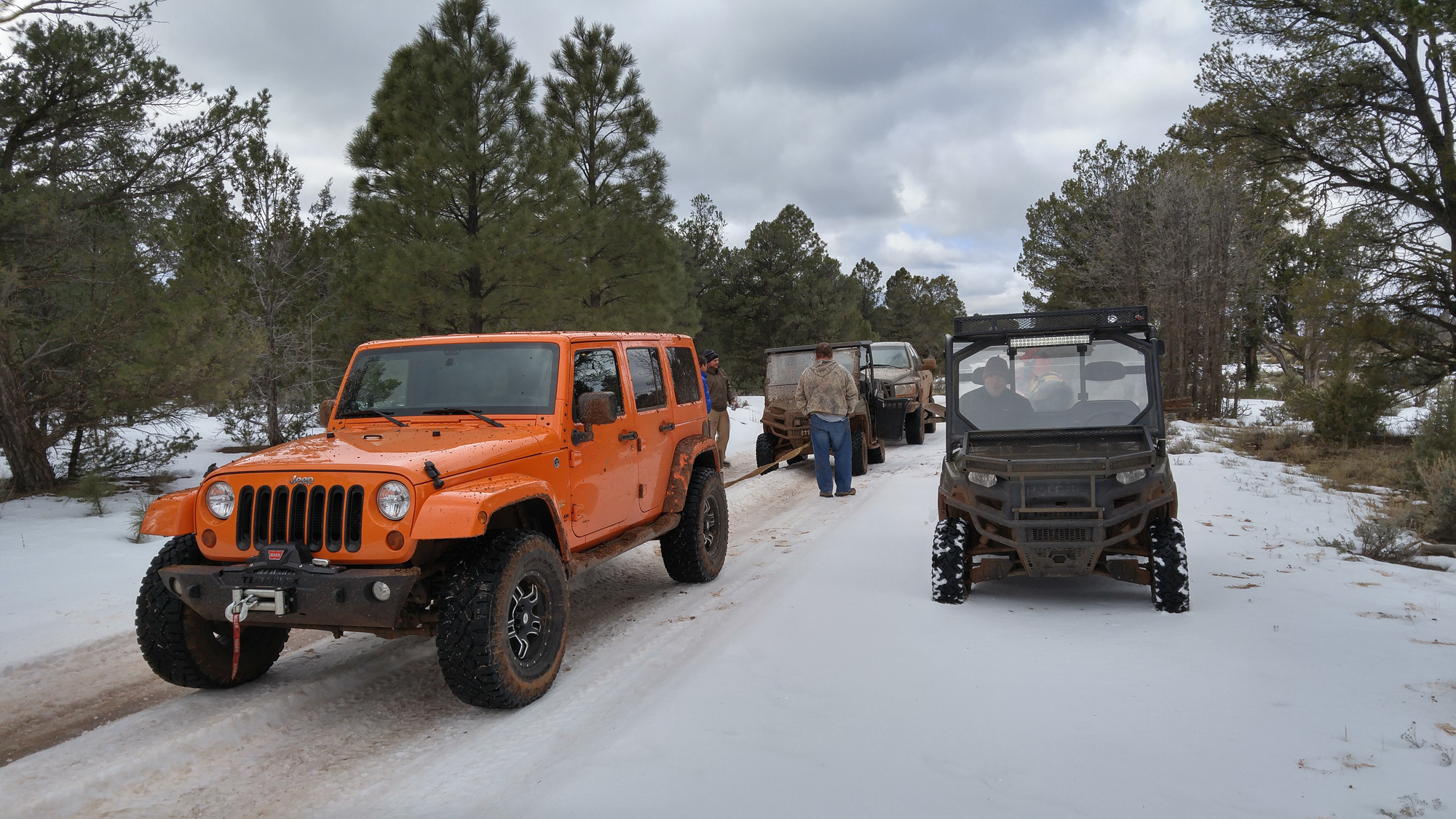
Towing the malfunctioning ranger home. Harlan did a great job driving the ranger behind Steve’s jeep.
The Ranger breaking down cost us precious time, and as we pressed on, things started to get muddy. What had been frozen mud on the way out was now quickly turning into a soupy, slick, mess that had claimed quite a few vehicles recently, as evidenced by all tracks that shot off the road where less fortunate vehicles had gotten stuck. Yet we pushed on, and soon found our wheels rolling on pavement – We had made it back to Tusayan.
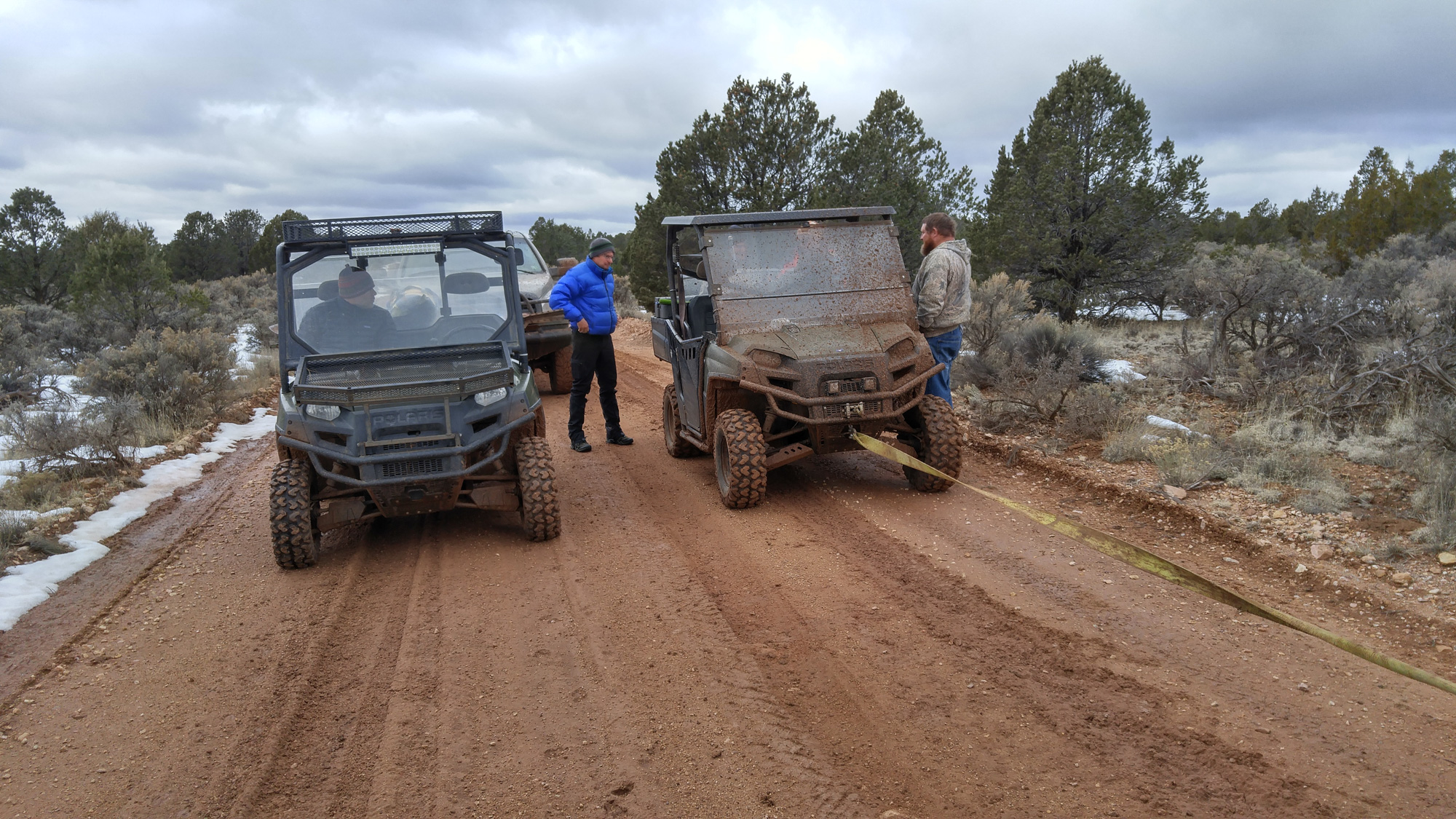
Stopping to check on the towed ranger.
Two days later, we once again found ourselves heading back to the South Bass trailhead. We had been driving for only a few minutes when tail lights started reflecting out of the darkness in the in the road ahead of me. The tail lights belonged to a Sedan that was parked smack dab in the middle of the road. Thinking the owner had abandoned the car and walked the several miles back to town, I started to pass around the car when a frantic owner materialized out of the car and flagged me down.
The guy claimed he was ‘trying to get to the visitor center for sunrise’ and that he was ‘following his GPS’ which lead him down a forest service road that is a very indirect way to the rim, in a car that was about as well equipped for travelling off road as a tour bus. Big surprise: he was stuck. We had to get the Nat Geo crew to the South Bass trail head before the thaw set in, so we made sure the guy had enough gear, food, and water to hold out until we could rescue him on our way back out. We gave the guy a quick tug back into the two track that was the road, and pressed on.
The rest of the trip to the trail head was uneventful, and we successfully dropped the Nat Geo crew off at the South Bass trailhead. We would be picking the National Geographic crew up in 12 days, and would then transition them to the North Rim of the Grand Canyon for the next leg of their 600+ mile expedition.
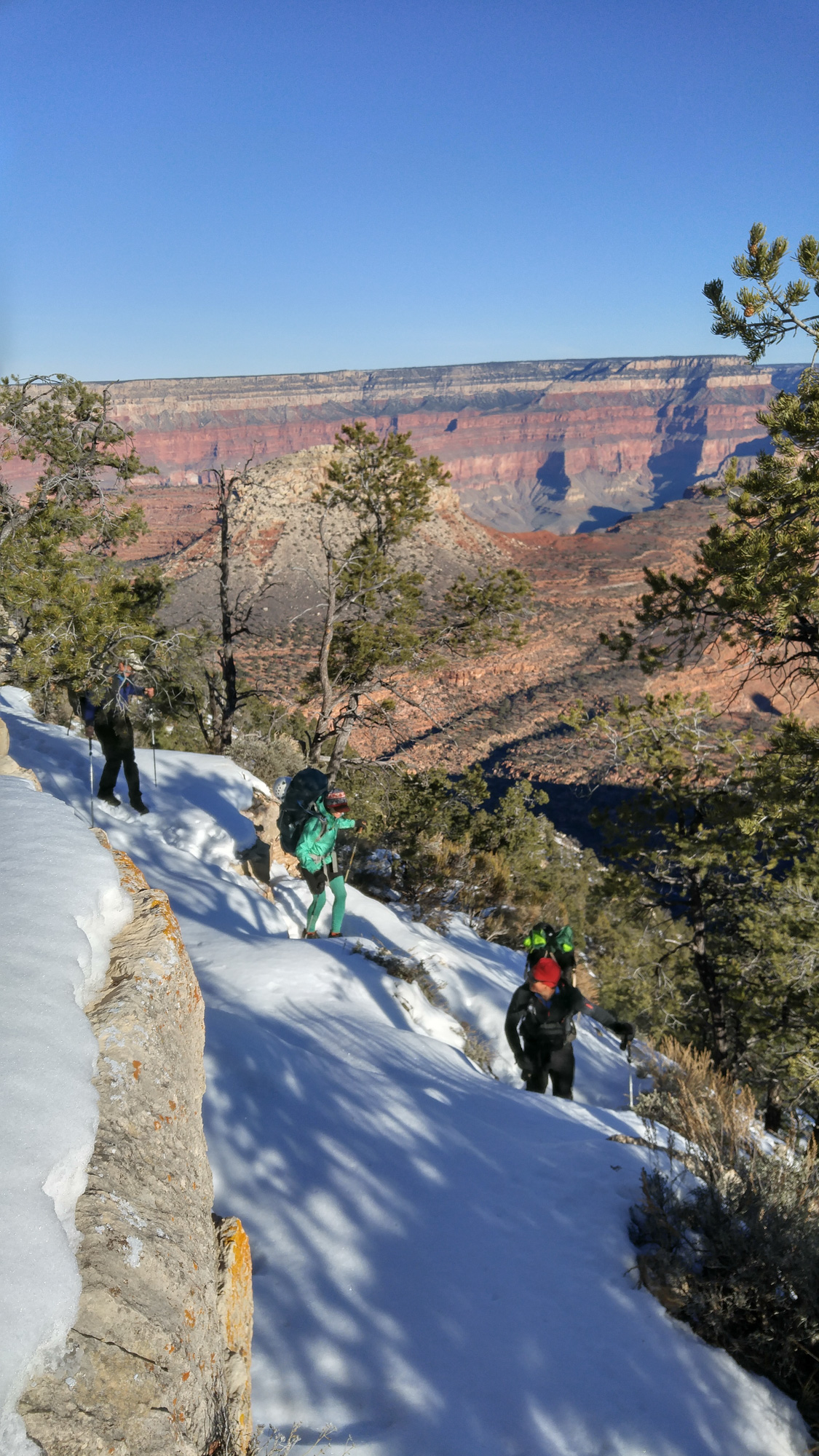
The Nat Geo crew sets off down the South Bass Trail.
Our return drive to Tusayan was trouble free, and to our surprise, the driver of the sedan had made it out. Maybe he got himself out, or maybe someone else had come along and was able to see him back to pavement. We’ll never know. What I do know is that at some point, one needs to put the phone down and think about what you’re doing. Just because someone has left tracks for you to follow, doesn’t mean that it’s a good idea to follow them. Sucker tracks are a thing, and that’s how folks get cliffed-out, or end up really stuck, or worse.
I’ll be posting our progress with the Nat Geo crew as soon as I can, so stay tuned!
